YAMAHA SUPERJET 2014 Workshop Manual
Manufacturer: YAMAHA, Model Year: 2014, Model line: SUPERJET, Model: YAMAHA SUPERJET 2014Pages: 78, PDF Size: 2.67 MB
Page 51 of 78
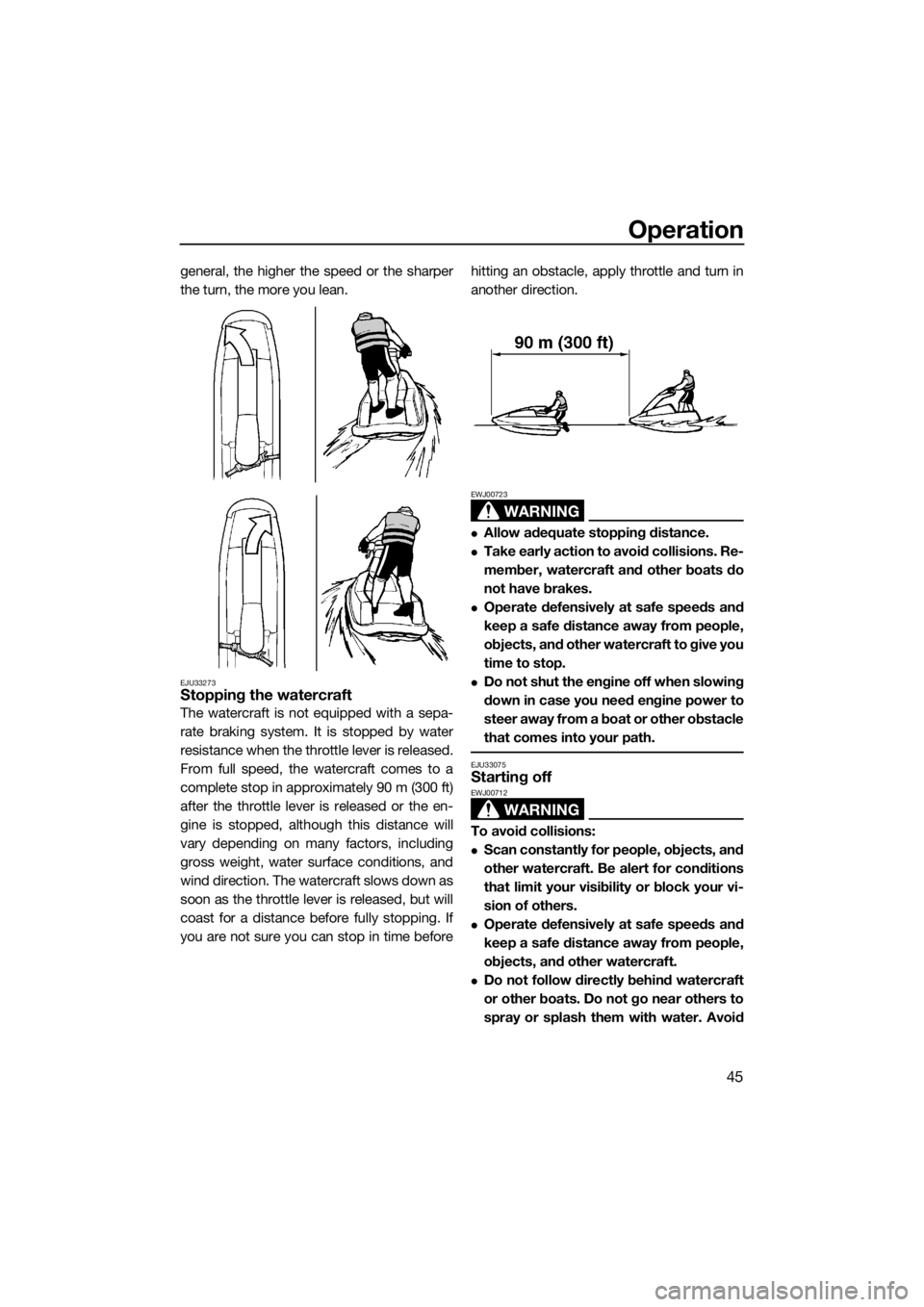
Operation
45
general, the higher the speed or the sharper
the turn, the more you lean.
EJU33273Stopping the watercraft
The watercraft is not equipped with a sepa-
rate braking system. It is stopped by water
resistance when the throttle lever is released.
From full speed, the watercraft comes to a
complete stop in approximately 90 m (300 ft)
after the throttle lever is released or the en-
gine is stopped, although this distance will
vary depending on many factors, including
gross weight, water surface conditions, and
wind direction. The watercraft slows down as
soon as the throttle lever is released, but will
coast for a distance before fully stopping. If
you are not sure you can stop in time beforehitting an obstacle, apply throttle and turn in
another direction.
WARNING
EWJ00723
Allow adequate stopping distance.
Take early action to avoid collisions. Re-
member, watercraft and other boats do
not have brakes.
Operate defensively at safe speeds and
keep a safe distance away from people,
objects, and other watercraft to give you
time to stop.
Do not shut the engine off when slowing
down in case you need engine power to
steer away from a boat or other obstacle
that comes into your path.
EJU33075Starting off
WARNING
EWJ00712
To avoid collisions:
Scan constantly for people, objects, and
other watercraft. Be alert for conditions
that limit your visibility or block your vi-
sion of others.
Operate defensively at safe speeds and
keep a safe distance away from people,
objects, and other watercraft.
Do not follow directly behind watercraft
or other boats. Do not go near others to
spray or splash them with water. Avoid
UF2F76E0.book Page 45 Thursday, May 9, 2013 3:52 PM
Page 52 of 78
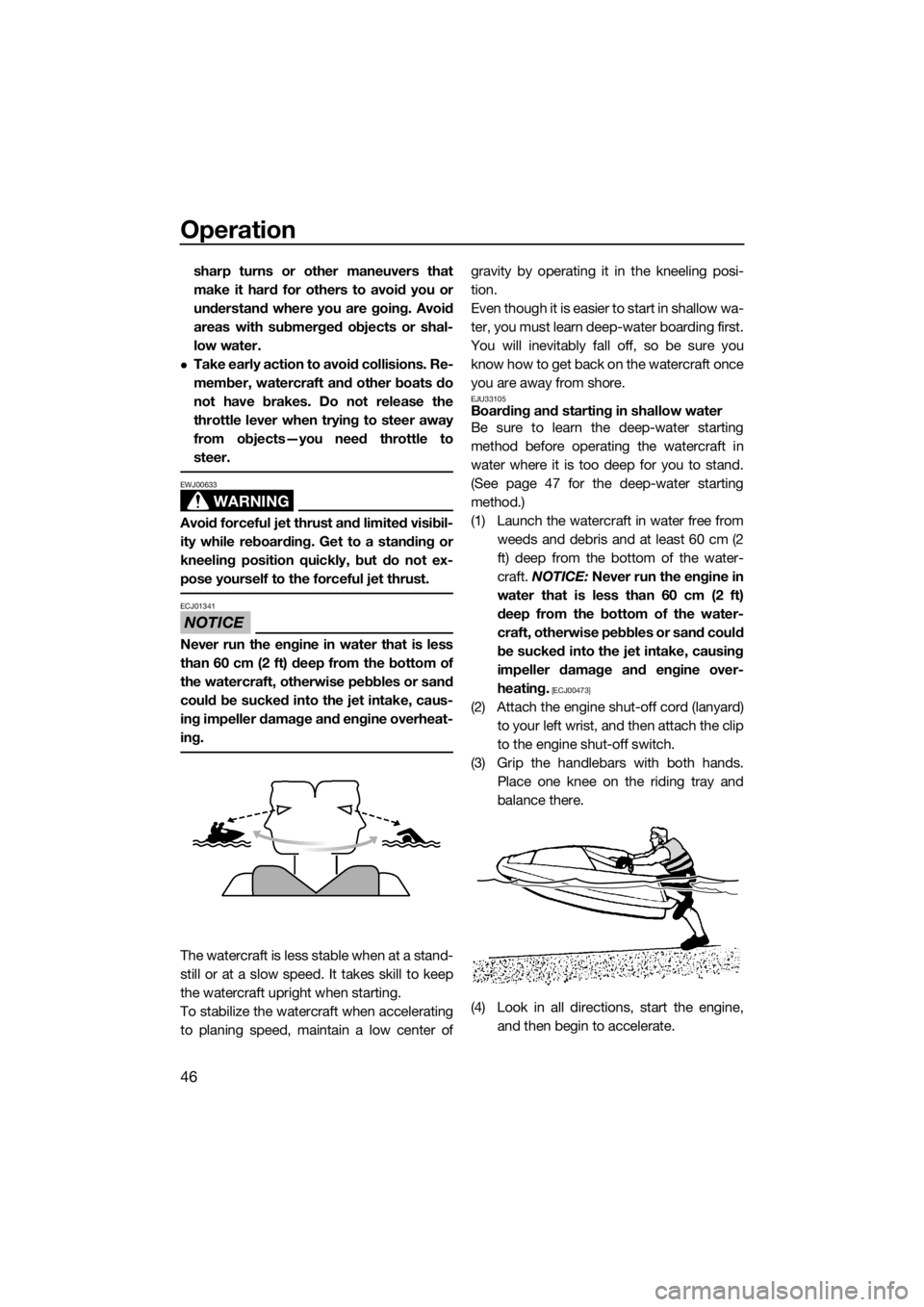
Operation
46
sharp turns or other maneuvers that
make it hard for others to avoid you or
understand where you are going. Avoid
areas with submerged objects or shal-
low water.
Take early action to avoid collisions. Re-
member, watercraft and other boats do
not have brakes. Do not release the
throttle lever when trying to steer away
from objects—you need throttle to
steer.
WARNING
EWJ00633
Avoid forceful jet thrust and limited visibil-
ity while reboarding. Get to a standing or
kneeling position quickly, but do not ex-
pose yourself to the forceful jet thrust.
NOTICE
ECJ01341
Never run the engine in water that is less
than 60 cm (2 ft) deep from the bottom of
the watercraft, otherwise pebbles or sand
could be sucked into the jet intake, caus-
ing impeller damage and engine overheat-
ing.
The watercraft is less stable when at a stand-
still or at a slow speed. It takes skill to keep
the watercraft upright when starting.
To stabilize the watercraft when accelerating
to planing speed, maintain a low center ofgravity by operating it in the kneeling posi-
tion.
Even though it is easier to start in shallow wa-
ter, you must learn deep-water boarding first.
You will inevitably fall off, so be sure you
know how to get back on the watercraft once
you are away from shore.
EJU33105Boarding and starting in shallow water
Be sure to learn the deep-water starting
method before operating the watercraft in
water where it is too deep for you to stand.
(See page 47 for the deep-water starting
method.)
(1) Launch the watercraft in water free from
weeds and debris and at least 60 cm (2
ft) deep from the bottom of the water-
craft. NOTICE: Never run the engine in
water that is less than 60 cm (2 ft)
deep from the bottom of the water-
craft, otherwise pebbles or sand could
be sucked into the jet intake, causing
impeller damage and engine over-
heating.
[ECJ00473]
(2) Attach the engine shut-off cord (lanyard)
to your left wrist, and then attach the clip
to the engine shut-off switch.
(3) Grip the handlebars with both hands.
Place one knee on the riding tray and
balance there.
(4) Look in all directions, start the engine,
and then begin to accelerate.
UF2F76E0.book Page 46 Thursday, May 9, 2013 3:52 PM
Page 53 of 78
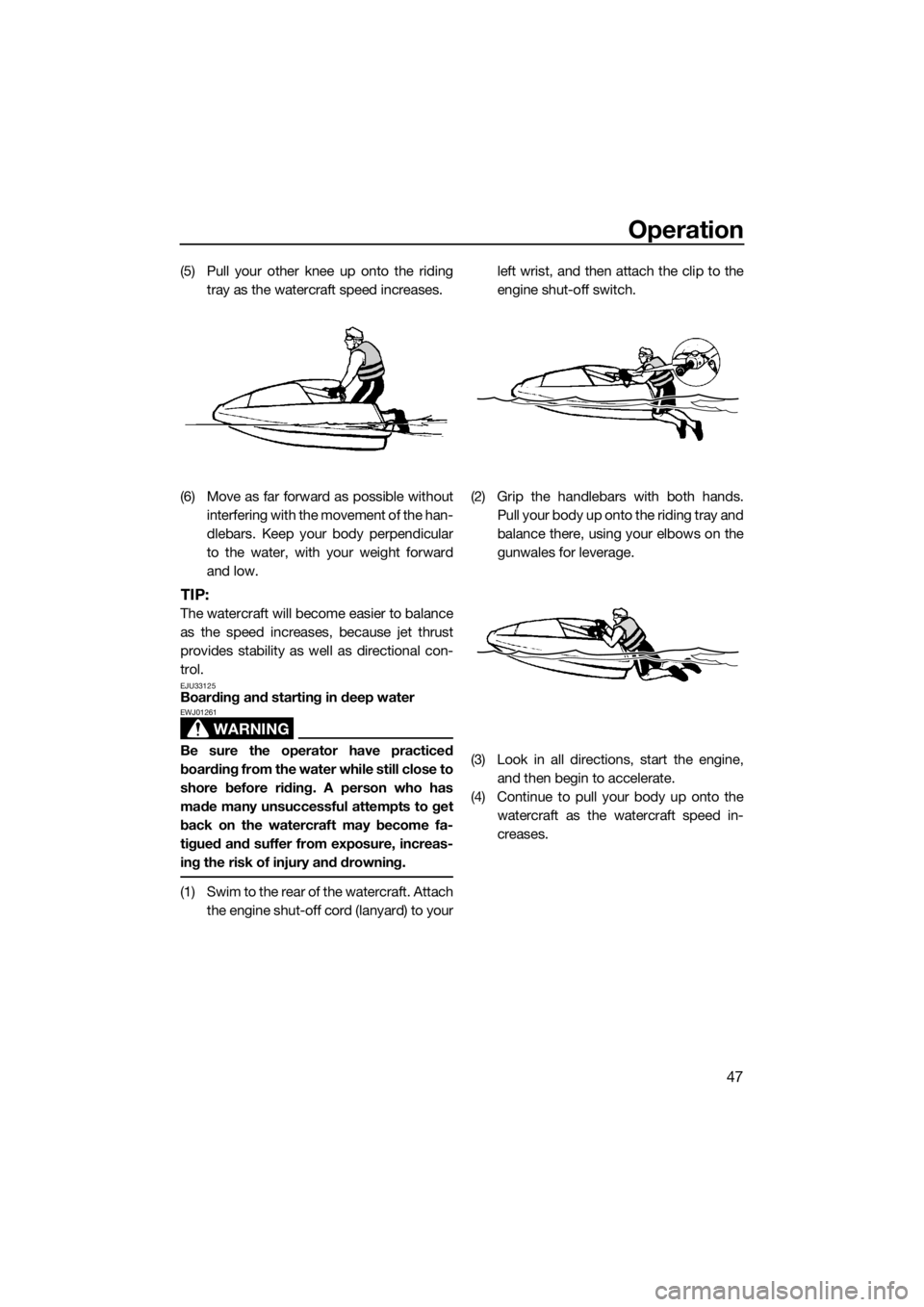
Operation
47
(5) Pull your other knee up onto the riding
tray as the watercraft speed increases.
(6) Move as far forward as possible without
interfering with the movement of the han-
dlebars. Keep your body perpendicular
to the water, with your weight forward
and low.
TIP:
The watercraft will become easier to balance
as the speed increases, because jet thrust
provides stability as well as directional con-
trol.
EJU33125Boarding and starting in deep water
WARNING
EWJ01261
Be sure the operator have practiced
boarding from the water while still close to
shore before riding. A person who has
made many unsuccessful attempts to get
back on the watercraft may become fa-
tigued and suffer from exposure, increas-
ing the risk of injury and drowning.
(1) Swim to the rear of the watercraft. Attach
the engine shut-off cord (lanyard) to yourleft wrist, and then attach the clip to the
engine shut-off switch.
(2) Grip the handlebars with both hands.
P u ll y o u r b o dy u p o n t o t h e r i d i n g t r ay an d
balance there, using your elbows on the
gunwales for leverage.
(3) Look in all directions, start the engine,
and then begin to accelerate.
(4) Continue to pull your body up onto the
watercraft as the watercraft speed in-
creases.
UF2F76E0.book Page 47 Thursday, May 9, 2013 3:52 PM
Page 54 of 78
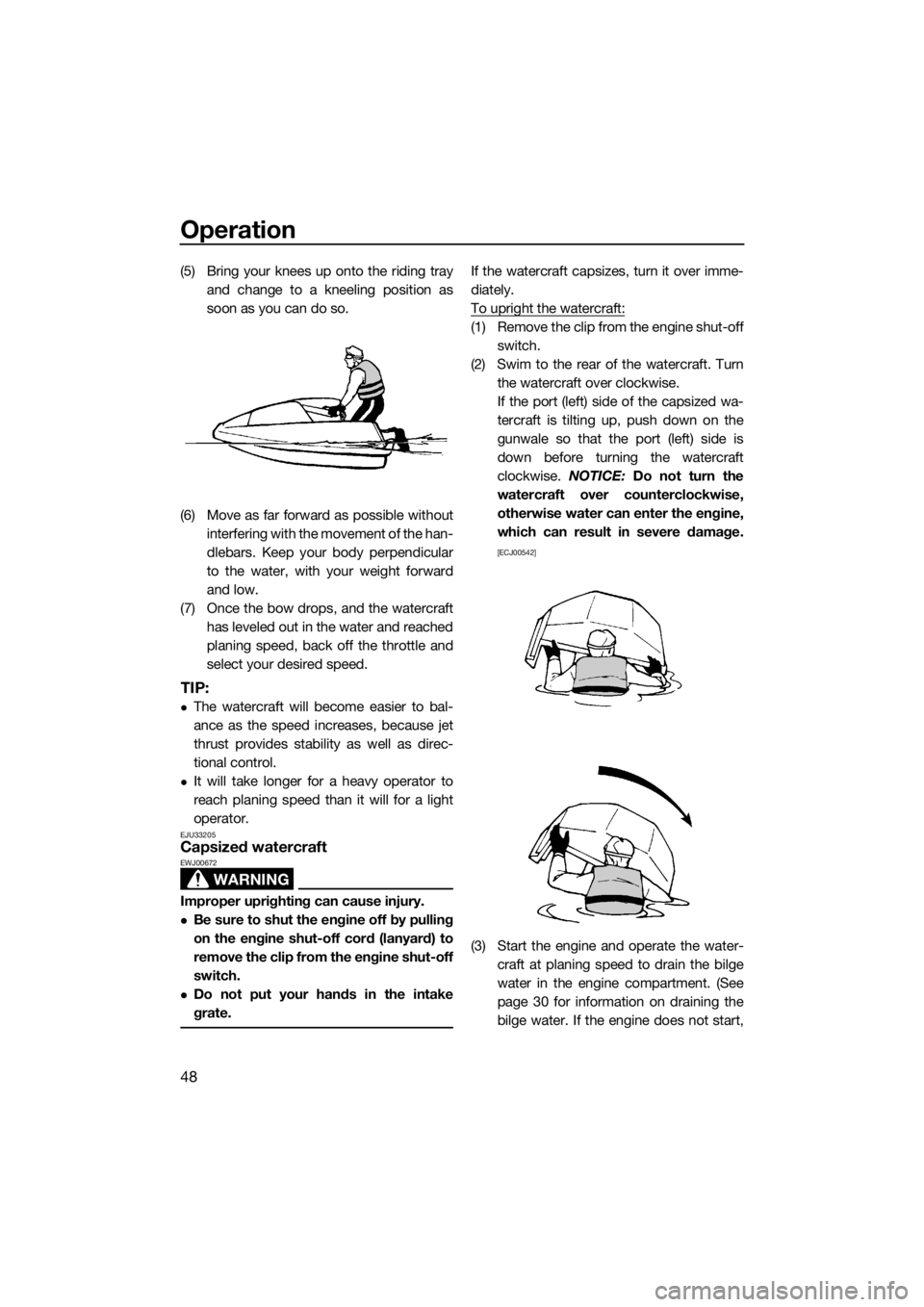
Operation
48
(5) Bring your knees up onto the riding tray
and change to a kneeling position as
soon as you can do so.
(6) Move as far forward as possible without
interfering with the movement of the han-
dlebars. Keep your body perpendicular
to the water, with your weight forward
and low.
(7) Once the bow drops, and the watercraft
has leveled out in the water and reached
planing speed, back off the throttle and
select your desired speed.
TIP:
The watercraft will become easier to bal-
ance as the speed increases, because jet
thrust provides stability as well as direc-
tional control.
It will take longer for a heavy operator to
reach planing speed than it will for a light
operator.
EJU33205Capsized watercraft
WARNING
EWJ00672
Improper uprighting can cause injury.
Be sure to shut the engine off by pulling
on the engine shut-off cord (lanyard) to
remove the clip from the engine shut-off
switch.
Do not put your hands in the intake
grate.
If the watercraft capsizes, turn it over imme-
diately.
To upright the watercraft:
(1) Remove the clip from the engine shut-off
switch.
(2) Swim to the rear of the watercraft. Turn
the watercraft over clockwise.
If the port (left) side of the capsized wa-
tercraft is tilting up, push down on the
gunwale so that the port (left) side is
down before turning the watercraft
clockwise. NOTICE: Do not turn the
watercraft over counterclockwise,
otherwise water can enter the engine,
which can result in severe damage.
[ECJ00542]
(3) Start the engine and operate the water-
craft at planing speed to drain the bilge
water in the engine compartment. (See
page 30 for information on draining the
bilge water. If the engine does not start,
UF2F76E0.book Page 48 Thursday, May 9, 2013 3:52 PM
Page 55 of 78

Operation
49
see “Towing the watercraft” on page 68
or “Submerged watercraft” on page 69.)
NOTICE: Do not run the engine at full
throttle for at least 1 minute after the
engine has been restarted. Bilge wa-
ter in the engine compartment can
splash into the engine, which can re-
sult in severe damage.
[ECJ00554]
EJU33303
Beaching the watercraft
To beach the watercraft:
(1) Make sure that there are no boats, swim- mers, or obstacles near the beach.
(2) Release the throttle lever to reduce speed about 90 m (300 ft) before you
reach the intended beaching area.
(3) Slowly approach the beach and stop the engine just before reaching land.
WARNING! You need throttle to steer. Shutting the engine off can cause you
to hit an obstacle you are attempting
to avoid. A collision could result in se-
vere injury or death.
[EWJ00602] NOTICE:
Never run the engine in water that is
less than 60 cm (2 ft) deep from the
bottom of the watercraft, otherwise
pebbles or sand could be sucked into
the jet intake, causing impeller dam-
age and engine overheating.
[ECJ00473]
(4) Get off the watercraft and pull it up on the beach.
EJU37194Operating in weeded areas
Always avoid using your watercraft in areas
where weed growth is thick. If operating in
weeded areas is unavoidable, alternately
squeeze the throttle lever and relax your grip
on the throttle lever to vary the engine speed.
Weeds tend to become clogged more when
operating at a steady speed and at trolling
speed. If weeds may have clogged the intake area, clean the jet intake. (See page 66 for in-
formation on the jet intake.)
EJU41061After removing the watercraft from
the water
NOTICE
ECJ01361
Do not run the engine for more than 15
seconds on land without supplying water,
otherwise the engine could overheat.
After operating and removing the watercraft
from the water, promptly discharge the re-
maining water from th
e cooling water pas-
sages.
To discharge water from the cooling water
passages:
(1) Make sure that the area around the wa- tercraft is clear, and then start the en-
gine.
(2) Discharge the remaining water out of the cooling water passages by alternately
squeezing and releasing the throttle lever
quickly for 10 to 15 seconds.
(3) Stop the engine.
UF2F76E0.book Page 49 Thursday, May 9, 2013 4:33 PM
Page 56 of 78
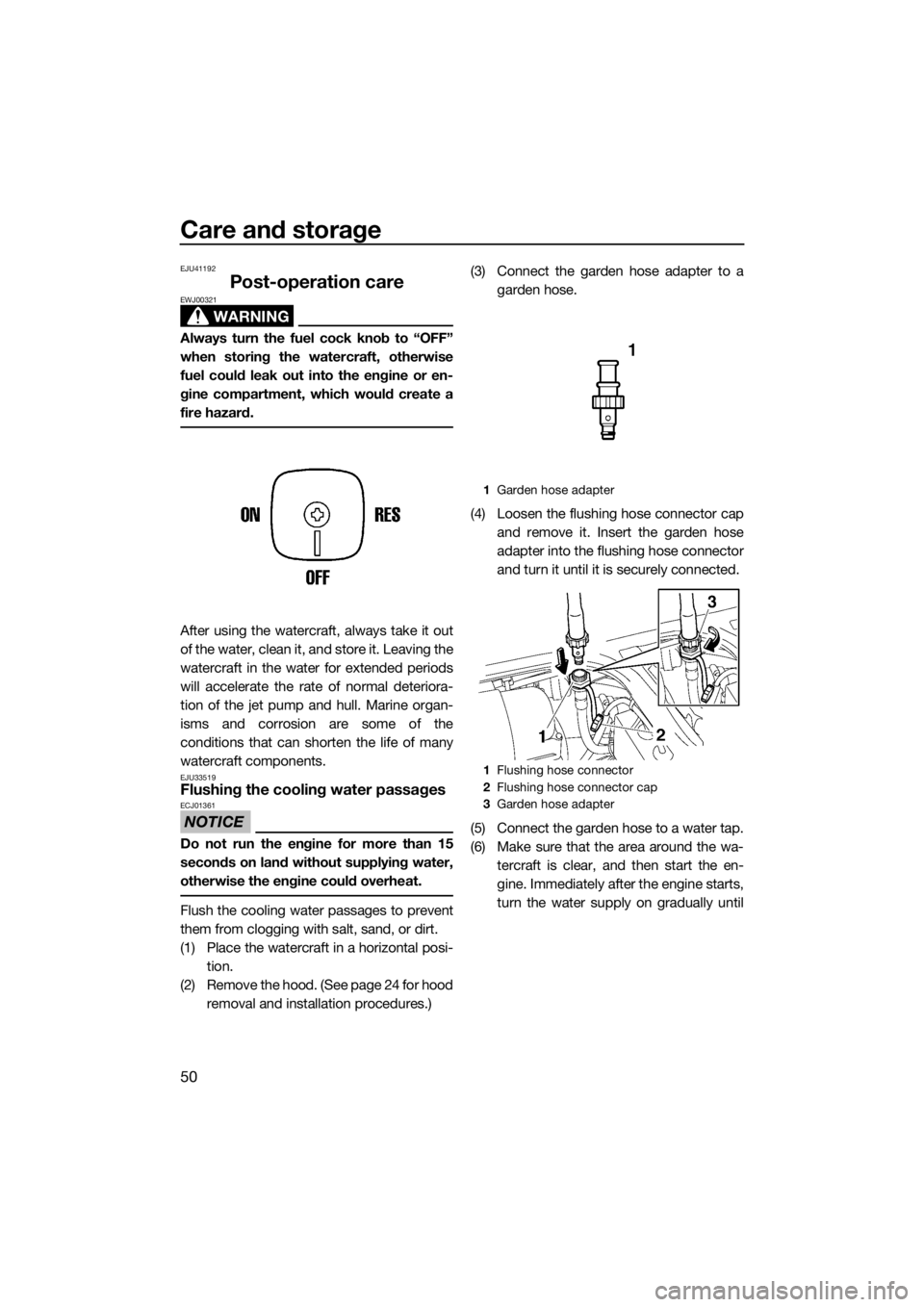
Care and storage
50
EJU41192
Post-operation care
WARNING
EWJ00321
Always turn the fuel cock knob to “OFF”
when storing the watercraft, otherwise
fuel could leak out into the engine or en-
gine compartment, which would create a
fire hazard.
After using the watercraft, always take it out
of the water, clean it, and store it. Leaving the
watercraft in the water for extended periods
will accelerate the rate of normal deteriora-
tion of the jet pump and hull. Marine organ-
isms and corrosion are some of the
conditions that can shorten the life of many
watercraft components.
EJU33519Flushing the cooling water passages
NOTICE
ECJ01361
Do not run the engine for more than 15
seconds on land without supplying water,
otherwise the engine could overheat.
Flush the cooling water passages to prevent
them from clogging with salt, sand, or dirt.
(1) Place the watercraft in a horizontal posi-
tion.
(2) Remove the hood. (See page 24 for hood
removal and installation procedures.)(3) Connect the garden hose adapter to a
garden hose.
(4) Loosen the flushing hose connector cap
and remove it. Insert the garden hose
adapter into the flushing hose connector
and turn it until it is securely connected.
(5) Connect the garden hose to a water tap.
(6) Make sure that the area around the wa-
tercraft is clear, and then start the en-
gine. Immediately after the engine starts,
turn the water supply on gradually until
1Garden hose adapter
1Flushing hose connector
2Flushing hose connector cap
3Garden hose adapter
UF2F76E0.book Page 50 Thursday, May 9, 2013 3:52 PM
Page 57 of 78
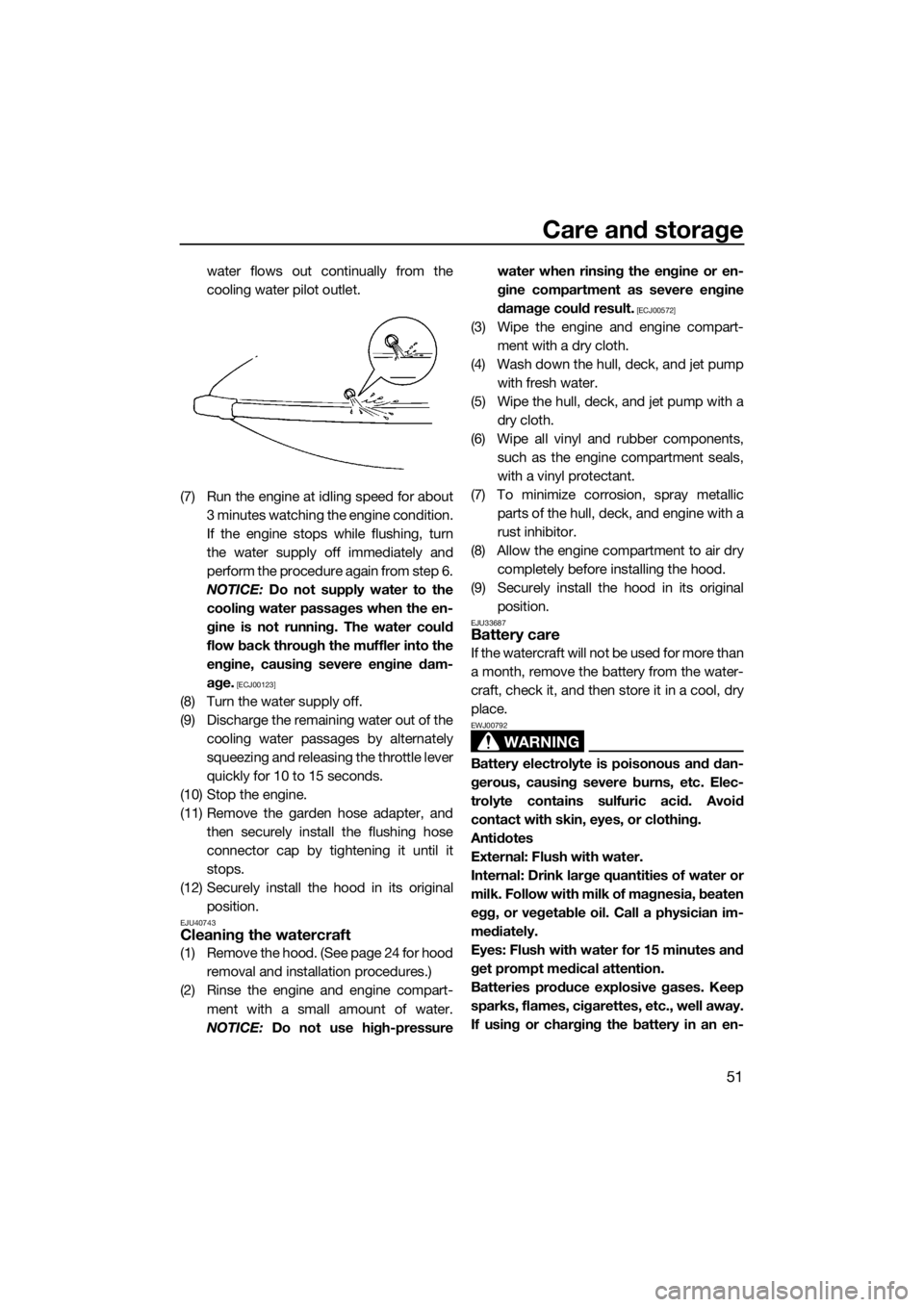
Care and storage
51
water flows out continually from the
cooling water pilot outlet.
(7) Run the engine at idling speed for about
3 minutes watching the engine condition.
If the engine stops while flushing, turn
the water supply off immediately and
perform the procedure again from step 6.
NOTICE: Do not supply water to the
cooling water passages when the en-
gine is not running. The water could
flow back through the muffler into the
engine, causing severe engine dam-
age.
[ECJ00123]
(8) Turn the water supply off.
(9) Discharge the remaining water out of the
cooling water passages by alternately
squeezing and releasing the throttle lever
quickly for 10 to 15 seconds.
(10) Stop the engine.
(11) Remove the garden hose adapter, and
then securely install the flushing hose
connector cap by tightening it until it
stops.
(12) Securely install the hood in its original
position.
EJU40743Cleaning the watercraft
(1) Remove the hood. (See page 24 for hood
removal and installation procedures.)
(2) Rinse the engine and engine compart-
ment with a small amount of water.
NOTICE: Do not use high-pressurewater when rinsing the engine or en-
gine compartment as severe engine
damage could result.
[ECJ00572]
(3) Wipe the engine and engine compart-
ment with a dry cloth.
(4) Wash down the hull, deck, and jet pump
with fresh water.
(5) Wipe the hull, deck, and jet pump with a
dry cloth.
(6) Wipe all vinyl and rubber components,
such as the engine compartment seals,
with a vinyl protectant.
(7) To minimize corrosion, spray metallic
parts of the hull, deck, and engine with a
rust inhibitor.
(8) Allow the engine compartment to air dry
completely before installing the hood.
(9) Securely install the hood in its original
position.
EJU33687Battery care
If the watercraft will not be used for more than
a month, remove the battery from the water-
craft, check it, and then store it in a cool, dry
place.
WARNING
EWJ00792
Battery electrolyte is poisonous and dan-
gerous, causing severe burns, etc. Elec-
trolyte contains sulfuric acid. Avoid
contact with skin, eyes, or clothing.
Antidotes
External: Flush with water.
Internal: Drink large quantities of water or
milk. Follow with milk of magnesia, beaten
egg, or vegetable oil. Call a physician im-
mediately.
Eyes: Flush with water for 15 minutes and
get prompt medical attention.
Batteries produce explosive gases. Keep
sparks, flames, cigarettes, etc., well away.
If using or charging the battery in an en-
UF2F76E0.book Page 51 Thursday, May 9, 2013 3:52 PM
Page 58 of 78
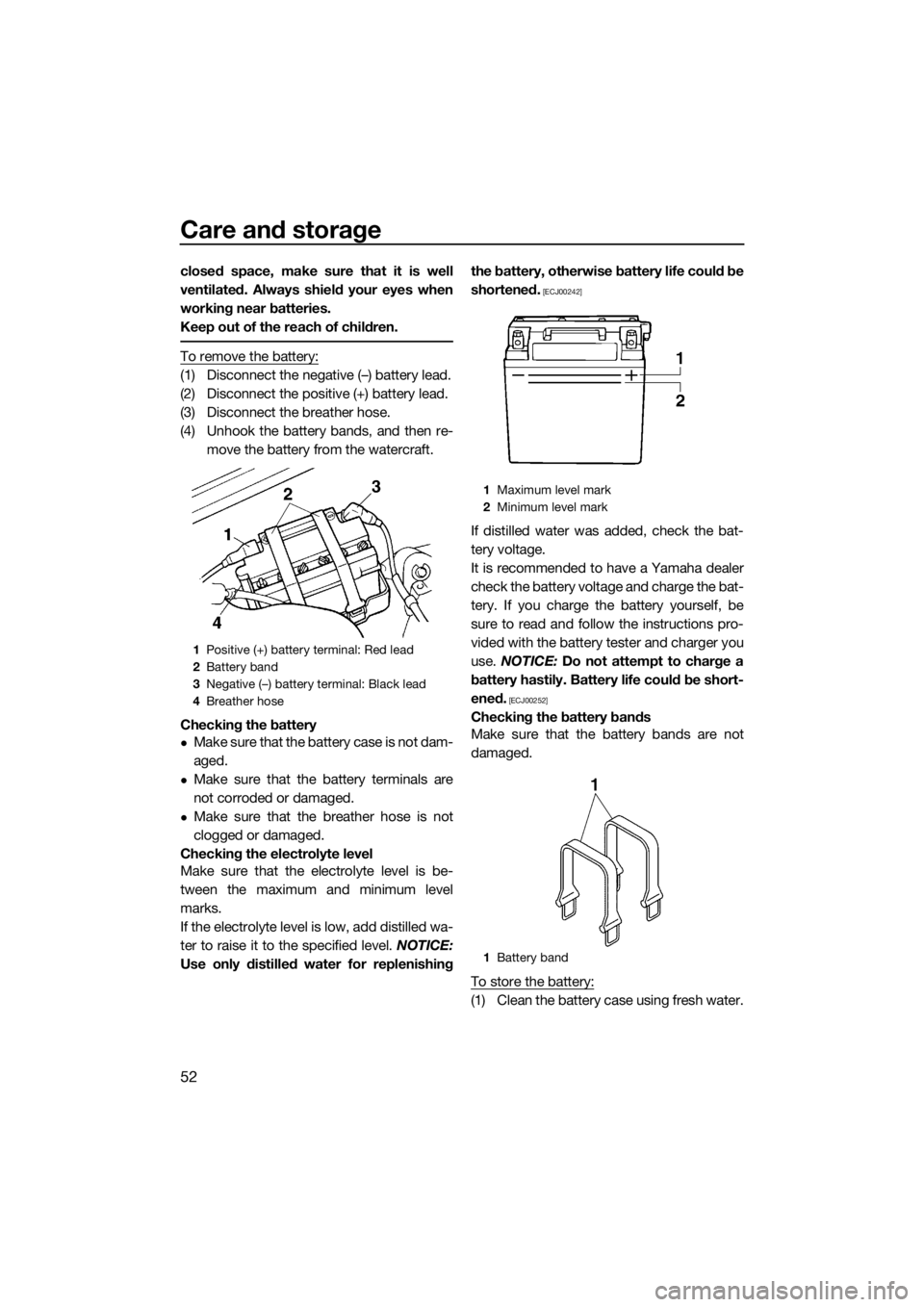
Care and storage
52
closed space, make sure that it is well
ventilated. Always shield your eyes when
working near batteries.
Keep out of the reach of children.
To remove the battery:
(1) Disconnect the negative (–) battery lead.
(2) Disconnect the positive (+) battery lead.
(3) Disconnect the breather hose.
(4) Unhook the battery bands, and then re-
move the battery from the watercraft.
Checking the battery
Make sure that the battery case is not dam-
aged.
Make sure that the battery terminals are
not corroded or damaged.
Make sure that the breather hose is not
clogged or damaged.
Checking the electrolyte level
Make sure that the electrolyte level is be-
tween the maximum and minimum level
marks.
If the electrolyte level is low, add distilled wa-
ter to raise it to the specified level. NOTICE:
Use only distilled water for replenishingthe battery, otherwise battery life could be
shortened.
[ECJ00242]
If distilled water was added, check the bat-
tery voltage.
It is recommended to have a Yamaha dealer
check the battery voltage and charge the bat-
tery. If you charge the battery yourself, be
sure to read and follow the instructions pro-
vided with the battery tester and charger you
use. NOTICE: Do not attempt to charge a
battery hastily. Battery life could be short-
ened.
[ECJ00252]
Checking the battery bands
Make sure that the battery bands are not
damaged.
To store the battery:
(1) Clean the battery case using fresh water.
1Positive (+) battery terminal: Red lead
2Battery band
3Negative (–) battery terminal: Black lead
4Breather hose
1Maximum level mark
2Minimum level mark
1Battery band
UF2F76E0.book Page 52 Thursday, May 9, 2013 3:52 PM
Page 59 of 78
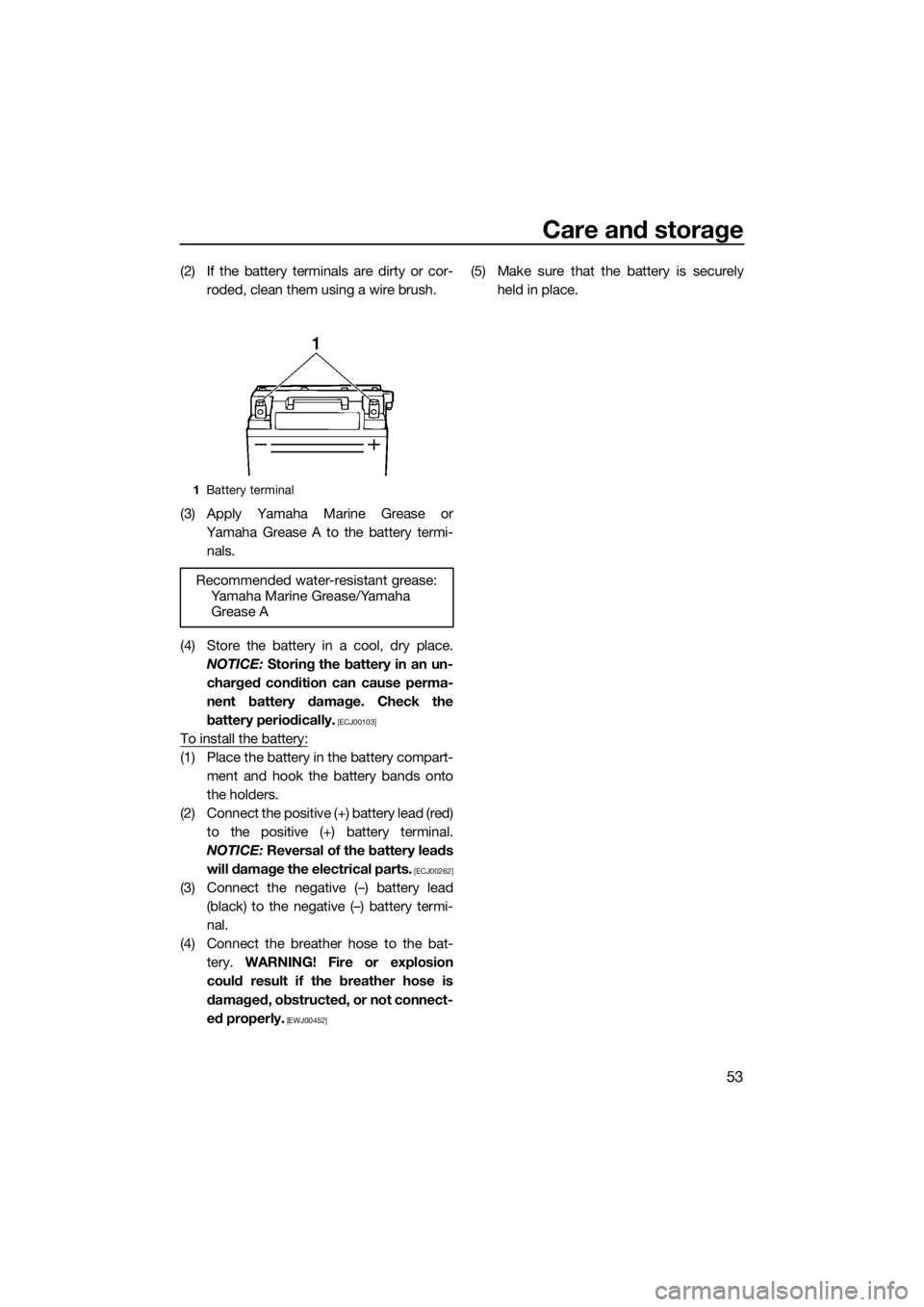
Care and storage
53
(2) If the battery terminals are dirty or cor-
roded, clean them using a wire brush.
(3) Apply Yamaha Marine Grease or
Yamaha Grease A to the battery termi-
nals.
(4) Store the battery in a cool, dry place.
NOTICE: Storing the battery in an un-
charged condition can cause perma-
nent battery damage. Check the
battery periodically.
[ECJ00103]
To install the battery:
(1) Place the battery in the battery compart-
ment and hook the battery bands onto
the holders.
(2) Connect the positive (+) battery lead (red)
to the positive (+) battery terminal.
NOTICE: Reversal of the battery leads
will damage the electrical parts.
[ECJ00262]
(3) Connect the negative (–) battery lead
(black) to the negative (–) battery termi-
nal.
(4) Connect the breather hose to the bat-
tery. WARNING! Fire or explosion
could result if the breather hose is
damaged, obstructed, or not connect-
ed properly.
[EWJ00452]
(5) Make sure that the battery is securely
held in place.
1Battery terminal
Recommended water-resistant grease:
Yamaha Marine Grease/Yamaha
Grease A
UF2F76E0.book Page 53 Thursday, May 9, 2013 3:52 PM
Page 60 of 78
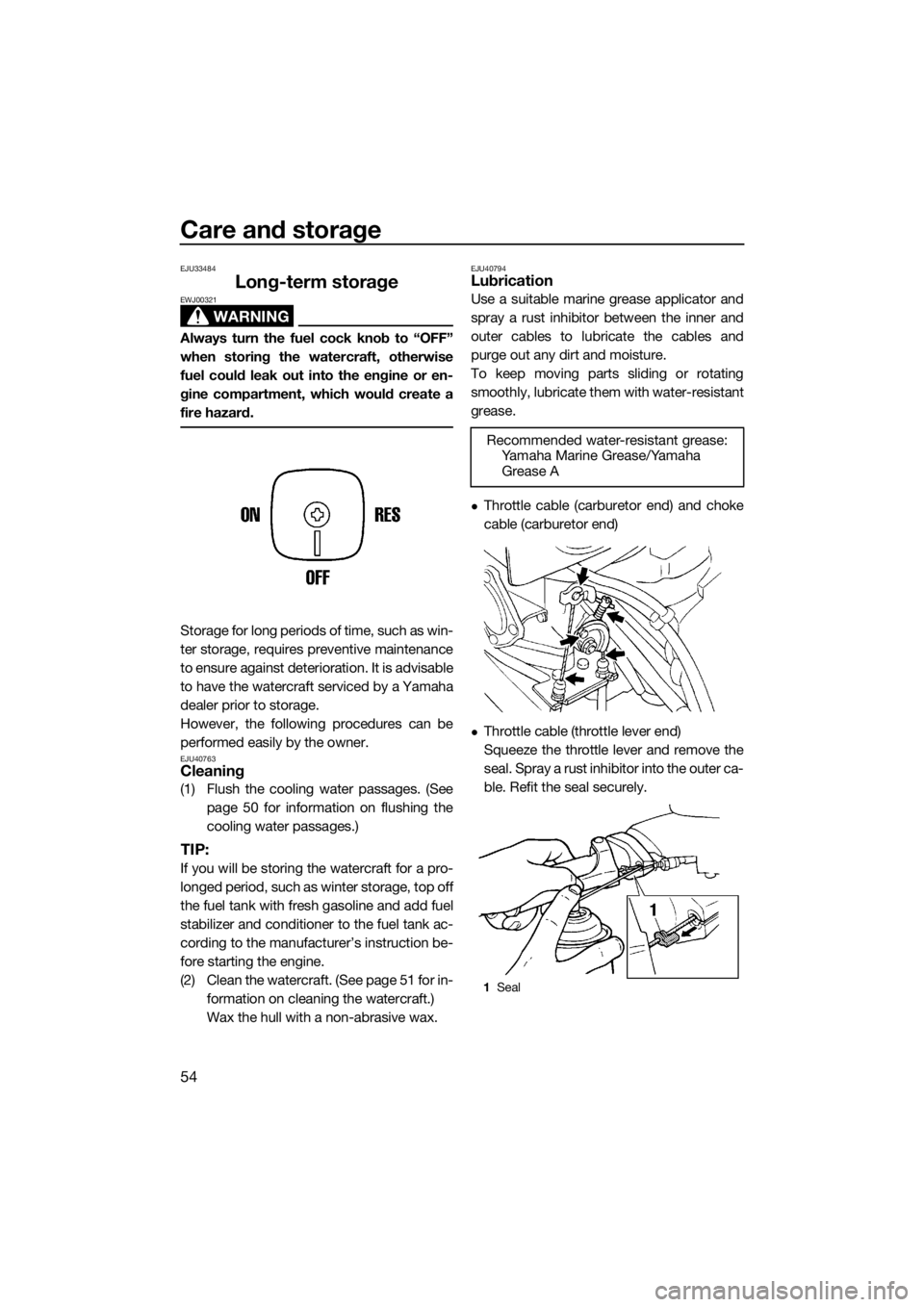
Care and storage
54
EJU33484
Long-term storage
WARNING
EWJ00321
Always turn the fuel cock knob to “OFF”
when storing the watercraft, otherwise
fuel could leak out into the engine or en-
gine compartment, which would create a
fire hazard.
Storage for long periods of time, such as win-
ter storage, requires preventive maintenance
to ensure against deterioration. It is advisable
to have the watercraft serviced by a Yamaha
dealer prior to storage.
However, the following procedures can be
performed easily by the owner.
EJU40763Cleaning
(1) Flush the cooling water passages. (See
page 50 for information on flushing the
cooling water passages.)
TIP:
If you will be storing the watercraft for a pro-
longed period, such as winter storage, top off
the fuel tank with fresh gasoline and add fuel
stabilizer and conditioner to the fuel tank ac-
cording to the manufacturer’s instruction be-
fore starting the engine.
(2) Clean the watercraft. (See page 51 for in-
formation on cleaning the watercraft.)
Wax the hull with a non-abrasive wax.
EJU40794Lubrication
Use a suitable marine grease applicator and
spray a rust inhibitor between the inner and
outer cables to lubricate the cables and
purge out any dirt and moisture.
To keep moving parts sliding or rotating
smoothly, lubricate them with water-resistant
grease.
Throttle cable (carburetor end) and choke
cable (carburetor end)
Throttle cable (throttle lever end)
Squeeze the throttle lever and remove the
seal. Spray a rust inhibitor into the outer ca-
ble. Refit the seal securely.
Recommended water-resistant grease:
Yamaha Marine Grease/Yamaha
Grease A
1Seal
UF2F76E0.book Page 54 Thursday, May 9, 2013 3:52 PM